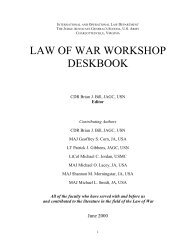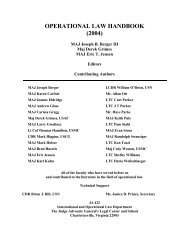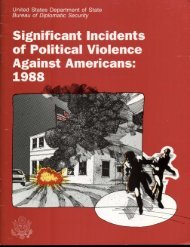OPEN SOURCE INTELLIGENCE - The Challenge for NATO - OSS.net
OPEN SOURCE INTELLIGENCE - The Challenge for NATO - OSS.net
OPEN SOURCE INTELLIGENCE - The Challenge for NATO - OSS.net
Create successful ePaper yourself
Turn your PDF publications into a flip-book with our unique Google optimized e-Paper software.
how to deal with new and indistinct boundaries among and between intelligence<br />
organizations and functions, and increasing ambiguity in roles and missions. Any intelligence<br />
officer who has ever worked at a senior level knows that senior policymakers and<br />
government officials abhor ambiguity; they want timely, accurate intelligence. As Peter<br />
Schwartz, a recognized futurist, founding member of the Global Business Network, and<br />
author of <strong>The</strong> Art of the Long View, told his audience at the Colloquium on the 21st Century,<br />
"We will see not only changing rules of the game, but new games. <strong>The</strong>re is an emerging<br />
competitive in<strong>for</strong>mation marketplace in which non-state intelligence will be `cheap, fast, and<br />
out of control.'"[5]<br />
Enthusiastic proponents of open source intelligence argue that the in<strong>for</strong>mation revolution is<br />
trans<strong>for</strong>ming the bulk of any nation's intelligence requirements and reducing the need to rely<br />
upon traditional human and technical means and methods. But Robin W. Winks,<br />
distinguished Yale University historian who served in the Office of Strategic Services during<br />
World War II and in its successor, the Central Intelligence Agency, concluded, "Research and<br />
analysis are at the core of intelligence . . . . [Most] `facts' are without meaning; someone must<br />
analyze even the most easily obtained data."[6]<br />
<strong>The</strong> emerging debate between investing in technology and developing competent analysts<br />
concerns itself basically with the value and role of open source intelligence. To understand<br />
some of the <strong>for</strong>ces that are shaping the debate, we need to weigh the relative benefits of<br />
primary and secondary sources, two discrete subsidiary classes of open source material.<br />
Primary sources, generally taken to include print and electronic media, have always provided<br />
in<strong>for</strong>mation of value to the intelligence community in current intelligence, indications, and<br />
warning as well as background in<strong>for</strong>mation used by analysts in their work. What the so-called<br />
in<strong>for</strong>mation revolution has done is to increase the ability of users to gain access and to<br />
manipulate the in<strong>for</strong>mation, and although most intelligence managers do not believe that the<br />
number of primary sources has expanded greatly, the number of secondary sources has<br />
increased exponentially. To compound the analyst's problem, the objectivity and reliability of<br />
many secondary sources are often questionable. We will need more experience be<strong>for</strong>e we can<br />
accept expansion of secondary sources as a benefit to the management of national security.<br />
<strong>The</strong> largest general open source collection in the world is the Library of Congress. To replace<br />
the original library, which was destroyed during the War of 1812, Congress in 1815<br />
purchased the private library of <strong>for</strong>mer President Thomas Jefferson, greatly increasing the<br />
collection's size and scope. <strong>The</strong> Library of Congress now includes works in more than 450<br />
languages and comprises more than 28 million books, periodicals, and pamphlets as well as<br />
manuscripts, maps, newspapers, music scores, microfilms, motion pictures, photographs,<br />
recordings, prints, and drawings. <strong>The</strong> library's services also include research and reference<br />
facilities, which coordinate with or amplify local and regional library resources.<br />
<strong>The</strong>re are also several thousand databases available from commercial organizations;<br />
LEXIS/NEXIS, Dialog, Reuters, and <strong>The</strong> New York Times come to mind.[7] Any discussion of<br />
contemporary open sources must now include the Inter<strong>net</strong> and the World Wide Web<br />
(WWW). <strong>The</strong> World Wide Web (developed in 1989) is a collection of files, called Web sites<br />
or Web pages, identified by uni<strong>for</strong>m resource locators (URLs). Computer programs called<br />
browsers retrieve these files.<br />
<strong>The</strong> term "Inter<strong>net</strong>" describes the interconnection of computer <strong>net</strong>works, particularly the<br />
global interconnection of government, education, and business computer <strong>net</strong>works, available<br />
19
















